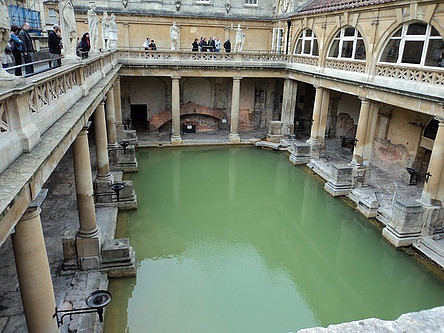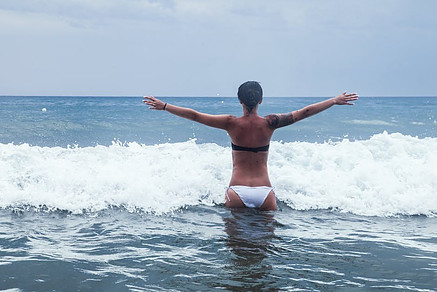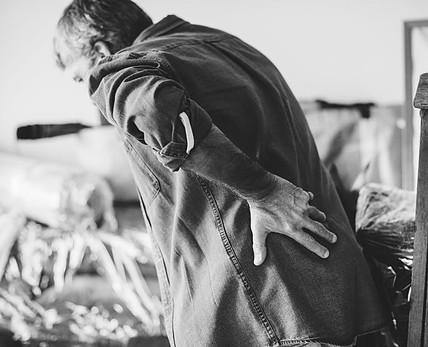So many types of therapies are within our reach. Do you know about thalassotherapy? What is the history of thalassotherapy? What are its benefits? Check out all the answers in this article.
Thalassotherapy (from the Greek Thalassa therapia): sea cure) can be defined as the combined use, under medical supervision, for preventive or curative purposes, of the benefits of the marine environment. This therapeutic treatment, obligatorily practiced at the seaside, is particularly indicated in the cases of degenerative rheumatism, vertebral pains, and certain dermatological affections.
Unlike the thermal world, the world of thalassotherapy is essentially reduced to the establishment, especially as, in the majority of cases, it has its own accommodation structure. Conversely, the town’s reputation or site is a success factor for a thalassotherapy institute.
Spa establishments offer (also) non-medical care (comfort), often called “fitness.”
The thalassotherapy establishments practice hydrotherapy using only seawater.
In a privileged marine site, thalassotherapy is the combined use, under medical supervision and for preventive and curative purposes, of the marine environment’s benefits, including the oceanic climate, seawater, marine mud, algae, sands, and other substances extracted from the sea.
Practiced since antiquity, thalassotherapy has therapeutic virtues: it helps relieve back pain, fibromyalgia, degenerative rheumatism, anxiety and depression, circulatory disorders, and skin problems. Thalassotherapy is very fashionable today, but what exactly is it?
1 – History of Thalassotherapy
The history of thalassotherapy goes back to the past. The therapeutic virtues of thalassotherapy have been known since Antiquity: Egyptians, Greeks, and Romans already used seawater in baths or affusion (= action of pouring water in a layer on the part of the body) and marine mud in fomentation (= external application of a hot medication) to cure their ills.
Centuries later, in 1865, the term “thalassotherapy” was officially born in France thanks to Dr. Joseph La Bonnardière, who had the idea to combine two Greek words to promote baths’ benefits with seawater: Thalassa means sea and therapy, that is, care or treatment. Let’s say he invented the word thalassotherapy in 1865, from 2 Greek words to mean “heal by the sea.”
*** Recent History of Thalassotherapy
Years later, in France, the growing enthusiasm for thalassotherapy brought about 150 doctors to meet in Boulogne-sur-Mer in 1894 for the first international conference on bathing and hydrology. The first institute of thalassotherapy, named the Marine Institute, opened its doors in Roscoff, on the Brittany coast, in 1899 under Dr. Louis-Eugène Bagot’s initiative.
Three generations of institutes will succeed one another:
– before 1960: functional rehabilitation centers on the model of Dr. Bagot;
– then the “Thalassotherapy Institutes,” less medicalized, with sporting patronage;
– the “spa-spas,” more luxurious, less medicalized yet.
In 1986, doctors, researchers, and leaders of thalassotherapy centers founded the International Thalassotherapy Federation, grouped in 2008 with the National Professional Thalassotherapy Syndicate under the name “France Thalasso.”
Good to know: Thalassotherapy has been implanted in North America for only a decade, but it is becoming more and more popular in Canada and particularly in Quebec. In this province, certain coastal areas have a marine climate that is extremely conducive to this therapeutic practice.
2 – What is Thalassotherapy?
Thalassotherapy uses seawater and, more broadly, the marine environment (seaweed, mud, sands, air, and sea climate …) for therapeutic purposes. It is always under medical supervision and obligatorily practiced at the seaside in specialized centers. Thalassotherapy provides many benefits, including regeneration of the body and strengthening of the immune system. It is also indicated in the prevention and treatment of lumbar pain (= back pain), fibromyalgia, degenerative rheumatism such as arthritis or osteoarthritis, blood circulation disorders, chronic heart failure, anxiety and depression, and even some dermatological conditions such as psoriasis.
Do you want to know more about the benefits of thalassotherapy? The following lines will answer your concern. Thanks for continuing to read!
3 – Seawater, Beneficial for Health
Thalassotherapy is based mainly on seawater use to regenerate the body and treat certain chronic conditions. Seawater contains many minerals essential to the body, such as sodium chloride (27 g per liter), potassium, magnesium, or calcium. Research by the French biologist René Quinton at the end of the 19th century has shown that the composition of seawater is surprisingly close to that of the human body’s internal liquids, including blood plasma and interstitial, also called extracellular fluid. In which “bathe” all the cells of the body. In other words, seawater and certain elements characteristic of the marine environment (algae, mud, sand, sea air) are beneficial for health since they bring trace elements, minerals, and vitamins essential to the body’s proper functioning.
In the 1960s, the work of Professor Jean-Jacques Dubarry revealed that after a swim of at least 15 minutes in seawater heated between 37 ° C and 40 ° C, the pores of the skin expand to facilitate the penetration and the immediate action of negative ions (= atoms carrying electric charge) on the body. Some negative ions like sodium ions and potassium ions penetrate through the skin barrier (= the skin) to reach the venous capillaries. They will then be distributed in the body according to their needs and deficiencies via the bloodstream. For example, the calcium ion will bind to the bones to consolidate, while the magnesium and potassium ions will promote muscle cells’ regeneration.
Ten years later, Professor Guelfi’s research confirms the transcutaneous penetration of negative ions in large quantities in seawater. The capture of negative ions by the tired organism thus promotes the cells’ natural renewal. The body recharges and regains all its energy. By soothing the mind and relieving general stress, heated seawater baths also provide mental health benefits.
Good to know: When heated to the right temperature, seawater helps prevent disease transmission. It is the phytoplankton that is at the origin of this phenomenon. These plant organisms live in suspension in water and release into the sea biochemical compounds with antiviral and antibacterial properties.
4 – Thalasso: The Benefits of Algae and Marine Mud
Thalassotherapy is not limited to seawater, but marine environment features such as seaweed and sea mud are also used in the care, including baths and wraps. These result in the local or total application of a hot solution (seaweed cream, a mixture of hot mud and seawater …), then wrapping the body in a heating blanket to promote penetration of marine active ingredients and eliminate toxins.
Algae have an exceptional concentration of mineral salts, trace elements, and vitamins (iodine, phosphorus, potassium, magnesium, iron, fluorine, and calcium …), up to 100,000 times higher than that of seawater. Algotherapy thus makes it possible to complete the fortifying and remineralizing effect of seawater treatments. Thanks to the presence of numerous mineral elements, algae have excellent antibacterial and antiviral properties and offer numerous health benefits: they purify the body, cleanse the skin, promote blood circulation, relieve symptoms of rheumatism, and regulate the thyroid gland.
Rich in negative ions from disintegrated marine flora and fauna, marine mud is known for its analgesic, anti-inflammatory, and detoxifying action. Mixed with seawater and applied as a poultice on painful areas of the body, mud can effectively fight against rheumatism and certain dermatological disorders. Care using marine mud has several advantages:
– During the session, the trace elements penetrate through the cutaneous barrier to reach the cells. The body is recharged with vitamins and regains all its vitality.
– Thanks to the detoxifying power of marine mud combined with the effect of heat, the pores of the epidermis open to release toxins accumulated by the body and get rid of its impurities. As a result, the skin is clean and soft.
This type of care favors the feeling of relaxation and the evacuation of daily life stress.
Good to know: For complete effectiveness, seaweed or mud wraps should last at least 25 minutes.
5 – Back Pain: Try Thalassotherapy!
Many thalassotherapy centers offer “special back” treatments, including several treatments adapted to back pain relief. First, a doctor makes a complete assessment to identify painful areas and prescribe the appropriate care.
In combination with jets of seawater, massage performed by physiotherapist massagers promotes the relaxation of muscles and the release of body tension. The relaxing and analgesic properties of this type of treatment help relieve lower back pain while improving blood circulation.
Heated seawater baths relax muscles and provide a deep sense of relaxation. In 2006, the authors of a meta-analysis evaluated data from 5 clinical trials involving 454 patients on the benefits of balneotherapy for back pain. The results showed that balneotherapy significantly reduced pain. A year earlier, the results of a clinical trial of 60 people with low back pain revealed that the benefits of balneotherapy were more significant if the water used was rich in sulfur (= the seawater is naturally charged in mineral salts). After two weeks of treatment, patients who were bathed with 30 minutes of sulfur-rich water daily experienced a decrease in pain intensity, significant relaxation of the para-vertebral muscles, decreased pain, and increased mobility. In 2009, following the analysis of 19 clinical trials, the European League Against Rheumatism (EULAR) confirmed the effectiveness of balneotherapy in relieving the symptoms associated with chronic low back pain.
Water aerobics or gym sessions can also be offered to patients with back pain. They allow you to stretch the muscles and tone them gently.
Thanks to their antalgic and anti-inflammatory properties, seaweed wraps or poultices of marine mud promote the relaxation of the painful muscles and decrease the intensity of the lumbar pains.
Good to know: The thalassotherapy centers offer a multitude of treatments (massages, massages, scrubs, showers, jets, whirlpools or hydromassage baths, re-education in the pool, water aerobics, wraps …) aimed at improving the general well-being or relieving specific ailments such as rheumatism, back pain, circulatory disorders, heart failure, fibromyalgia, insomnia, depression, smoking cessation or certain skin diseases. A cure in a thalassotherapy center, whatever the pathology to be treated, lasts an average of 18 days.
6 – Thalasso to Fight Against Fibromyalgia
Fibromyalgia is a little-known disease whose causes are still poorly understood. It is characterized mainly by distressing and diffuse muscular pains in the whole body, although no lesion is visible in the muscles. Other symptoms such as sleep disorders, tiredness, tingling in the feet and hands, headaches, or anxiety can be caused by fibromyalgia. Although the pathology does not cause any complications in the long term, it represents a real handicap to the point that those who suffer from it fail to work full-time and have difficulty performing specific daily life tasks. According to the Ministry of Health, fibromyalgia affects about 2% of the population in France. In Canada, more than 900,000 people would suffer.
Thalassotherapy, especially balneotherapy and pool exercises, would help relieve fibromyalgia symptoms. According to a systematic review of 10 clinical trials published in 2008, thalassotherapy and, more generally, balneotherapy (= external use of water for therapeutic purposes) used as a complementary treatment could reduce the intensity of muscular pain caused by fibromyalgia, as well as the number of pain points. It would improve the overall well-being and quality of life of patients. The benefits of hydrotherapy would last even several months (between 3 and 6 months) after the treatment. However, due to the low quality of some of the methodologies, the review authors note that further studies need to be conducted to confirm hydrotherapy’s actual effect on fibromyalgia symptoms.
Another study conducted in 2008 with 46 women with fibromyalgia showed that aerobic exercise in seawater improved the general health and well-being of subjects by acting on the symptoms related to the pathology. Participants, who performed aerobic exercises for 12 consecutive weeks, experienced a significant decrease in pain points all over their body, even within a few months after the end of treatment.
7 – Relieving Rheumatism with Thalassotherapy
The virtues of thalassotherapy are now recognized in the relief of rheumatism, such as arthritis or osteoarthritis. Numerous clinical trials have been conducted on the subject: hydrotherapy performed in various forms (baths, water jets, wraps …) reduces the intensity of pain related to rheumatism, including osteoarthritis of the knees and the hip, significantly improves the functional capacity of patients and promote well-being. The advantage of this therapeutic approach is that it has no side effects; thalassotherapy can then be used to complement drug treatment.
Regarding rheumatoid arthritis, a systematic review published in 2003 and gathering six clinical trials for a total of 355 participants revealed that balneotherapy had positive effects on this degenerative disease: two problems reported a marked improvement in the quality of life in patients with arthritis. However, the authors explain that the positive results reported by some clinical trials should be considered with caution because of the low quality of the protocols.
As a Conclusion
Thalassotherapy brings real benefits to the body and mind. There are several types of Thalassotherapy treatments:
– Affusion Modeling
A hydrotherapist carries out a massage with essential oils of the whole body under a slight shower of the warm sea. The exceptional properties of the seawater used, taken off the premises, filtered, and heated, combined with the benefits of essential oils (orange, lemon balm, and marjoram) and a unique modeling protocol lasting 25 minutes, allow deep muscular relaxation and great relaxation.
– Algae Wrap
It is one of the leading treatments of Thalassotherapy. Its relaxing and detoxifying effectiveness is increased tenfold by the exclusive seaweed cream’s unique richness. This is indeed the most concentrated market. A draining rinse with warm seawater follows the wrap.
– The Underwater Shower
This powerful underwater hydromassage of the whole body takes place in a bathtub filled with seawater by a hydrotherapist, according to a precise and exclusive protocol, for deep drainage and relaxation.
– Dynamic Affusions
In this treatment, the body is massaged by several curtains of jets of warm seawater that intersect frequently. Sedative and deeply relaxing, this unique protocol owes its effectiveness to the affusion bar of the establishment: exclusive and patented, this unique ramp in the world allows the jets to intersect randomly and continuously over a large surface to massage the body—the whole body, including all the “motor” parts of the body, for deep relaxation.
– The Jets Bath with Essential Oils
This relaxing multi-sensory treatment combines the mechanical action of a whirlpool and multi-jet, the benefits of seawater enriched with essential oils, and light therapy—a deep relaxation of the body as the spirit.
– Pool with Cervical and Lumbar Jets
Made in a dedicated seawater pool, this series of exercises performed in front of a submarine jet located on the cervical or lumbar region can deeply relax the muscles and tone the body.
– Aquarelaxation
This relaxation session takes place in a pool of heated seawater totally dedicated. A physiotherapist specifically trained in this new discipline accompanies the participant, supported by floats, in deep aquatic relaxation by verbal inductions.
And Last but Not Least
Thalasso Strunjan, the only health resort on the Slovenian coast, is part of the Terme Krka. It is located near the village of Strunjan in the Municipality of Piran.
